

The Bologna National Art Gallery is one of Italy's most prestigious art institutions, located in the heart of Bologna, a city with a rich cultural heritage. The gallery’s origins can be traced back to the Academy of Fine Arts (Accademia di Belle Arti) established in 1711. The collection was initially started to provide inspiration and study material for the academy's students. Over time, thanks to various donations and acquisitions, the gallery amassed an extensive collection of artworks, especially from the Emilian school.
The gallery boasts an impressive collection that spans several centuries, showcasing masterpieces from the 13th to the 18th centuries. Notable artists whose works are on display include Raphael, Carracci, Guido Reni, and Titian. The collection provides insight into the progression of Italian art, with a special emphasis on the Bolognese school.
Tourism at the Bologna National Art Gallery began to gain prominence as the reputation of its collection grew. Art enthusiasts and scholars from all over the world have been drawn to Bologna to witness its vast array of paintings and sculptures. The rise of educational travel in the 19th and 20th centuries saw an increase in visitors to cultural institutions like the gallery, solidifying its place as a significant cultural destination.
Over the years, the gallery has enhanced the visitor experience by organizing temporary exhibits, guided tours, and educational programs, aiming to make the artworks more accessible to a wider audience. Improvements in display techniques and the modernization of the museum's facilities have made the gallery both a treasure trove for connoisseurs and a delightful experience for casual visitors.
In recent times, the Bologna National Art Gallery has embraced the latest in tourism trends. There has been a shift towards digitalization with virtual tours and online databases allowing those unable to travel to the gallery to enjoy its collection. Sustainable tourism is also a focus, with efforts to minimize the environmental impact of the gallery and its visitors. Encouraging off-peak visits and promoting lesser-known works help to distribute tourist numbers throughout the year, balancing visitor flows and preserving the experience quality.
The future of tourism at the Bologna National Art Gallery looks promising, with continuous efforts to preserve the collection and educate the public. There is an ongoing commitment to making the gallery an inclusive space that promotes diversity and engagement with all communities, ensuring that its legacy continues for generations to come.